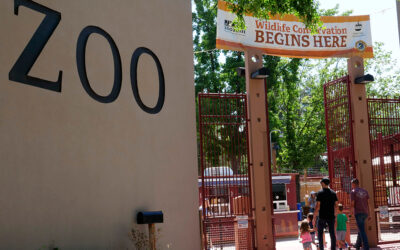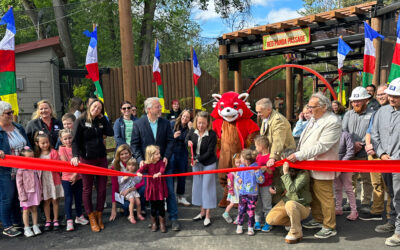This past summer, three Zoo Boise staff traveled to El Salvador to educate and train animal care professionals working with the country’s National Program for Spider Monkey Conservation.
Let’s learn how this trip came together, why we wanted to go, and what positive outcomes are already being applied in El Salvador.

How Did Zoo Boise Receive This Opportunity?
The invite came courtesy of Paso Pacífico, one of Zoo Boise’s conservation partners. A non-profit that focuses on the restoration and protection of tropical ecosystems along Mesoamerica’s Pacific coast, Paso Pacífico has been a recipient of Zoo Boise Conservation Funds grants since 2019.
Those grants have helped fund El Salvadoran community rangers and purchased trail and digital cameras for species documentation, among other projects.
So, when El Salvador’s Ministry of Environment and Natural Resources reached out to Paso Pacífico in early 2022 about assistance regarding rescued spider monkey training and care… they knew who to call to be a part of the collaboration thanks to our established relationship.

Why El Salvador?
El Salvador, like many other Central American countries, has a problem with illegal wildlife trade. Wild animals are harvested for products, as well as taken for pets. Spider monkeys specifically are targeted throughout Central and South America. In a brutal process, many mother monkeys are shot while their baby is attached to them; the baby is then taken into the illegal trade. They are sold to people or businesses who want monkeys as pets or mascots.
Being intelligent primates, spider monkeys likely become traumatized by this tragic experience. Their strife is then furthered when held in poor conditions.
When monkeys are rescued from these situations by the government, officials are left with mentally scarred monkeys. Many times, local agents have no idea where the monkeys came from, where they’ve been, or what they’ve been through.
Zoo Boise was asked to aid various institutes from across El Salvador so they can develop practices to better rehabilitate these rescued, mostly non-releasable spider monkeys.
Meet the Team
A zoo veteran of nearly 30 years, Zoo Boise Director Gene Peacock got his start as a zookeeper at the Natural Science Center in Greensboro, North Carolina. He has since held positions as a zookeeper, area manager, and zoo director at zoos across the country prior to arriving in Boise in 2018.
Gene served as the primary point of contract between Zoo Boise and all involved parties before, during, and after the trip. He also put his animal care training skills into practice and assisted with training sessions.

Interpretation Coordinator Austin Reich led the educational components of the workshops. Chosen for his experience working in Central America (and his ability to speak Spanish), this Certified Interpretive Guide (CIG) had the ideal background to connect with the El Salvadoran teams.
A former ZooTeen and volunteer at Zoo Boise, Austin’s work as a college undergrad in frog bioacoustics helped inform other scientists of potential undescribed species in the jungles of Costa Rica. He joined Zoo Boise staff in 2021 after earning a Bachelor of Science in Ecology & Biodiversity and becoming a published researcher along the way.
Fulfilling a childhood dream to visit Central American rainforests, Animal Training Coordinator Nicole Villeneuve was another perfect choice to lead the trip.
Nicole earned a Bachelor of Science in Agricultural & Environmental Education from UC Davis and has honed her craft since working at a California Fish & Wildlife refuge and later at the Folsom City Zoo Sanctuary as a lead keeper for the omnivore herbivore section.
You can find her these days at Zoo Boise as a zookeeper throughout the Gorongosa National Park Exhibit.

Who Else Was Involved?
Sarah Otterstrom, Director of Paso Pacífico, greeted the Zoo Boise trio in El Salvador and spent a few days showing them around. She was also involved in the workshops.
Elena Castro is the National Program for Spider Monkey Conservation’s project coordinator. She serviced as the trip’s primary organizer and workshop host.
What We Did
Before diving into the crux of the trip, Gene, Austin, and Nicole, along with Sarah, toured the region to meet park rangers (some funded by Paso Pacífico through Zoo Boise) and see first-hand the beautiful habitats Zoo Boise supporters are helping to preserve.
Next, approximately 20 animal care professionals and conservationists from all over El Salvador took part in three days of hands-on workshops and exercises centered on the ethical care, rehabilitation, and husbandry of monkeys.
Conservation and educational topics (including diet, social structure, enrichment, and housing) were covered in classroom lessons, too.
One male spider monkey in particular, named Pancho, would not allow anybody near him and was very aggressively defensive when our team first arrived at the animal sanctuary housing the workshops. The El Salvadoran zookeepers didn’t believe anyone could get close to the frantically afraid animal without first physically restraining him. A recent arrival, Pancho was found with a long piece of rope tied around his neck – resembling a crude leash.
At the end of workshop day one, it was on everybody’s mind to figure out how to calmly remove this rope. Nicole and one of the local keepers, Wilber, approached and introduced Pancho to a type of animal training using a target item. They reinforced his reaction and rewarded him with dried fruit and granola. After successful interactions for five minutes, the pair decided to continue training the next day.
(Zoo Boise’s animal care staff uses target training with many different species. It involves working with individual animals to encourage them to present a certain body part or move to a specific location when prompted. The training is mainly used for medical or other animal welfare needs.)
The following morning, Wilber was not present as workshops began. An hour later, he joined the group and quietly told everyone he removed the rope on Pancho!
It turns out that Wilber did more target training with the monkey the night before and early that morning. He was late to the workshop because he was cutting off the restraint.
Pancho’s entire demeanor had changed overnight. He no longer screamed or shook the fence when people walked by. He grew particularly fond of Wilber. Everybody was very impressed with Wilber and could clearly see how simple training techniques would be beneficial.
We have recently received videos from Wilber obtaining blood draw samples from Pancho using procedures and more positive reinforcement methods learned from Zoo Boise.
Seeing this success was the buy-in our new-found friends in El Salvador needed to erase the curiosity or skepticism they may have initially had about our credibility for establishing trust with traumatized animals.
“Everyone was extremely welcoming and enthusiastic. Most expressed gratitude and even disbelief that we wanted to visit,” Nicole said. “Since returning… I have thought about [the trip] every single day, and I still talk with people we met both about work topics and as friends.”

How We’ve Helped
An overarching goal of the National Program for Spider Monkey Conservation is to not only provide better care for rescued spider monkeys, but to also raise awareness and spread appreciation for a species that lives in their country. Education can inspire local communities to care about monkeys and other wildlife while discouraging the illegal pet trade and its cruel practices.
In addition to direct impacts – as illustrated by the story about spider monkey Pancho – Zoo Boise is helping out in several more ways:
Our zoo veterinarian – Dr. Melissa Cavaretta – is working with El Salvador’s National Program for Spider Monkey Conservation veterinarians to better develop processes for medical testing to gain an improved understanding of primate genetics so they can learn what monkey sub-species they have. This will play a role in determining which animals may be candidates for possible release after rehabilitation.
Learning that many of the rescued animals cannot be released, we’ve started coordinating with other AZA [Association of Zoos and Aquariums] institutes to possibly place some these animals (including spider monkeys, reptiles, and over three dozen parrots and macaws of various species). So far ten different U.S. zoos are interested in helping give these animals new, non-invasive homes.

Closer to Home
Elvis and Sarah, the spider monkeys here at Zoo Boise, likely have similar backstories to the spider monkeys rescued in El Salvador. They were surrendered to the zoo by a family that kept them as pets.
Luckily for Elvis and Sarah, Zoo Boise took them in and provide them with excellent care. Professional animal care staff with decades of knowledge determine their diet and veterinary care. We’re also part of a great zoological network that can help answer questions.
Elvis may, in fact, be the oldest spider monkey under human care in the world. He turned 60 years old this year; spider monkeys typically live 20-40 years.
El Salvador’s institutes have significantly fewer luxuries and resources. Sharing our knowledge directly with those caring for spider monkeys there will be invaluable for the welfare of those monkeys and their counterparts in the wild.
We were only able to take this trip and make these connections due to Zoo Boise’s guests and generous donors. Part of every zoo admission, membership, and daily encounter directly supports our conservation fund.
Thank you to all who support conservation programs and efforts like our team’s visit to El Salvador.



